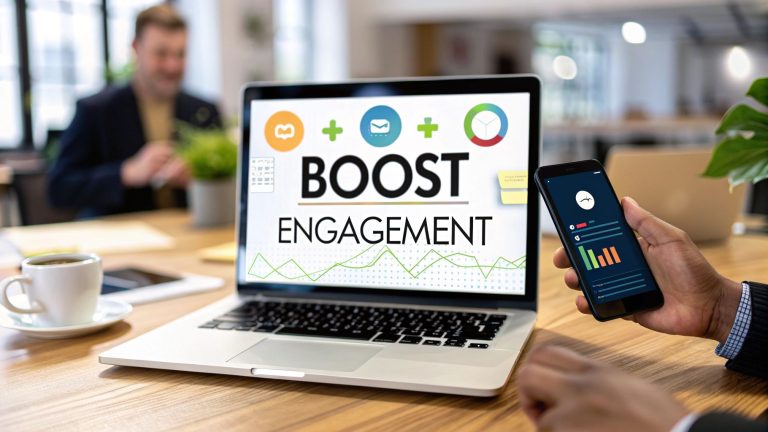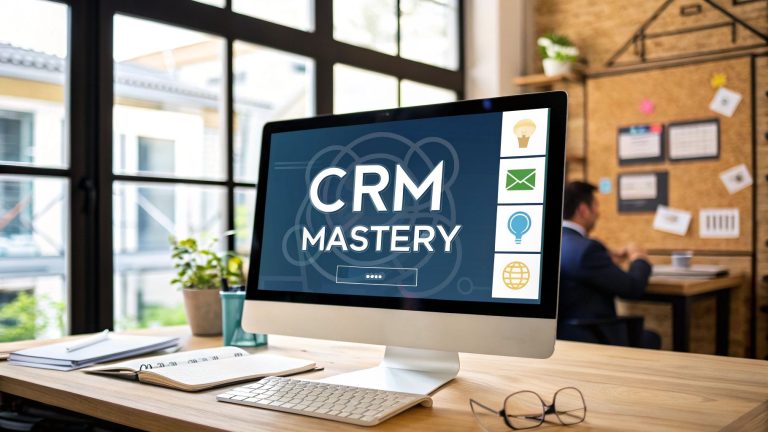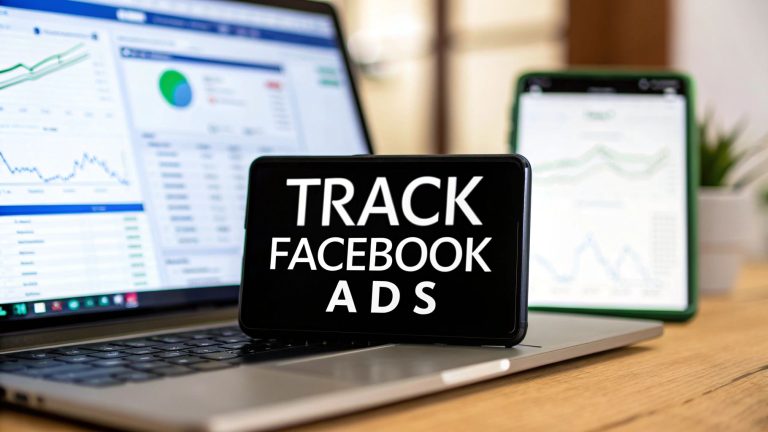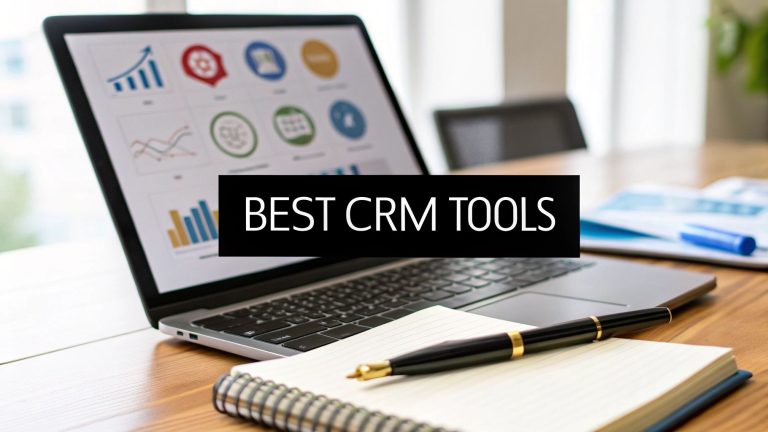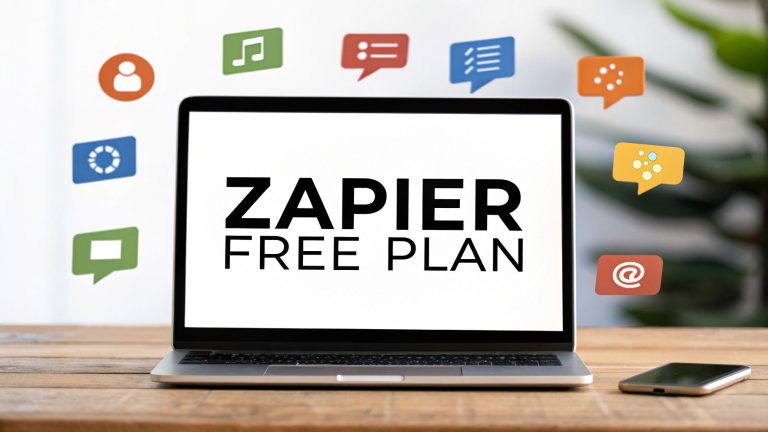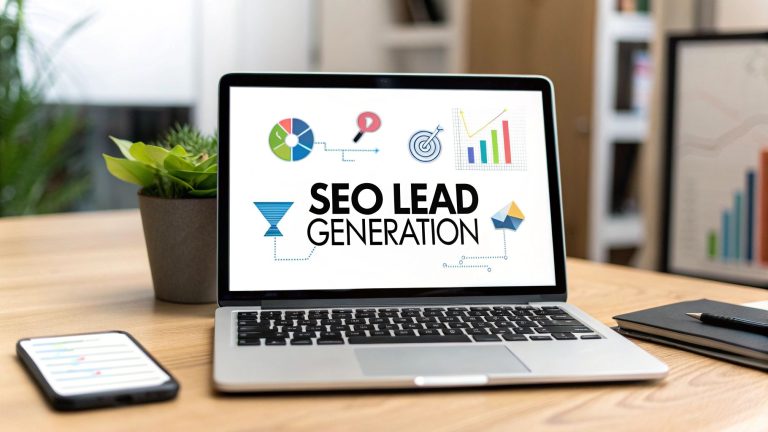Facebook Ads Automation The Ultimate Guide
Think of Facebook ads automation as your expert co-pilot. It’s the smart technology that takes over the tedious, repetitive parts of managing your ad campaigns—like tweaking budgets or A/B testing audiences—so you can focus on the big picture stuff like strategy and creative.
What Is Facebook Ads Automation
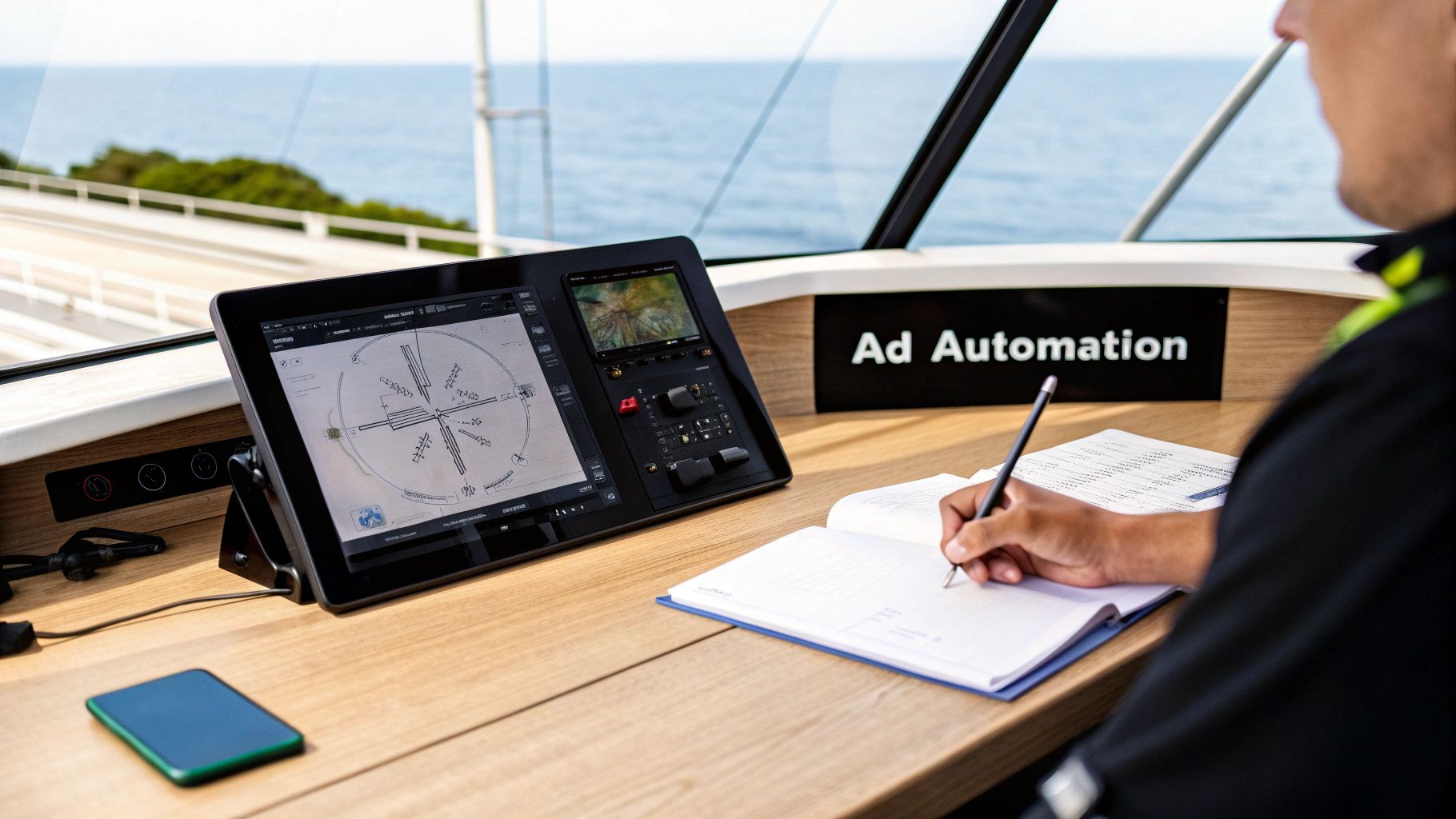
Imagine trying to steer a massive cargo ship through a storm, scrambling to adjust the sails with every gust of wind. That's a lot like managing a large-scale Facebook ads account manually. You're constantly checking performance data, shutting down ads that aren't working, and moving your budget around to the winners.
Facebook ads automation is the high-tech autopilot system for that ship. It makes thousands of tiny adjustments in real-time, ensuring you stay on the most profitable course without you having to be at the helm 24/7.
But let's be clear: this isn't some "set it and forget it" magic button. It's a powerful assistant that crunches data and executes tasks at a speed and scale no human ever could. By handing off the grunt work, you’re free to pour your energy into what really moves the needle: crafting killer creative, refining your offers, and thinking about your next big strategic move.
The Core Concepts of Automation
At its heart, automation is all about using pre-set rules and machine learning to make smart decisions on the fly. It chews through mountains of real-time campaign data to optimize for your specific goals, whether that's getting more leads or driving sales. This whole process is built on the same principles that power other business systems; you can learn more about the fundamentals by understanding what is workflow automation.
To help you get a handle on how this all works, we've broken down the key concepts driving Facebook ads automation.
Key Facebook Ads Automation Concepts at a Glance
| Automation Concept | What It Is | Primary Benefit |
|---|---|---|
| Automated Bidding | Letting Meta's algorithm handle your bids to maximize results based on your campaign goal. | Gets you the most bang for your buck without manual guesswork. |
| Dynamic Creative | Providing a set of ad components (images, headlines, text) that Facebook mixes and matches automatically. | Discovers the highest-performing ad combinations for different audiences. |
| Rule-Based Optimization | Setting "if-then" rules to manage your campaigns (e.g., "IF cost per lead > $20, THEN pause ad"). | Prevents wasted ad spend and keeps campaigns profitable on autopilot. |
These three pillars work together to create a smarter, more efficient advertising machine.
Why It Matters Now More Than Ever
The ad world is getting smarter, and leaning on data-driven tools is no longer optional. The global marketing automation market is on track to hit $15.62 billion by 2030. That explosive growth is happening for one simple reason: it gets incredible results. Businesses are seeing an average return of $5.44 for every dollar spent on automation tools.
Automation isn't just a time-saver. It unlocks a level of performance and precision that's flat-out impossible to achieve by hand. It gives a small team the power and sophistication of a massive agency.
Ultimately, bringing automation into your Facebook ads strategy means you can run campaigns that are more efficient, more scalable, and more profitable. You get to step out of the reactive, day-to-day grind of campaign management and become the proactive strategist who's focused on one thing: growth.
Why Automation Is a Non-Negotiable Advantage
Jumping into Facebook ads automation isn't just about adding a new tool to your stack; it's about completely changing how you approach growth.
Trying to manage campaigns manually is like trying to catch falling rain in a teacup. Sure, you’ll get a few drops, but you’re going to miss the downpour. Automation, on the other hand, is like setting up an industrial-grade collection system, making sure you capture every single opportunity, at scale.
This isn't some vague, futuristic concept. It delivers real, tangible value in three key areas: reclaiming your time, getting better results, and unlocking explosive growth. By getting a handle on Facebook ads automation, you're not just saving a few hours; you're building a smarter, stronger, and more resilient advertising machine from the ground up.
Reclaim Your Time with Unmatched Efficiency
The first thing you'll notice with automation is the freedom. You're suddenly free from the tedious, repetitive tasks that eat up a marketer's day.
Think about all those hours spent manually tweaking budgets, pausing underperforming ads one by one, or launching yet another A/B test for a tiny variation. These tasks are a necessary evil when you're doing things by hand, but they're the first things you should hand over to an automated system.
An automated rule or system can check your campaigns every single minute, 24/7. It doesn't get tired, it never forgets to check in, and it won't make a costly mistake because it's late on a Friday. This lets you point your most valuable asset—your brain—at the stuff that actually moves the needle.
- Creative Strategy: Instead of fiddling with bids, you can be dreaming up your next killer ad concept.
- Offer Development: Forget staring at spreadsheets; you can be refining your offers to get more people to convert.
- Audience Research: You finally have the time to dig into new markets and find untapped customer segments.
This change turns you from a reactive campaign technician into a proactive growth strategist.
Drive Superior Results with Algorithmic Performance
Human gut feelings are great, but they can't go toe-to-toe with an algorithm that crunches millions of data points in real-time. Meta's AI is built to do one thing incredibly well: find the most efficient way to hit your campaign goal. Whether you're trying to lower your Cost Per Acquisition (CPA) or pump up your Return on Ad Spend (ROAS), the system’s learning capabilities will almost always beat manual efforts over time.
Picture an e-commerce brand running a flash sale. A marketing manager might check performance every hour and move the budget to the best-performing creative. That’s good, but it’s not great.
With automation, the system can shift that budget in real-time—minute by minute—to jump on micro-trends and tiny spikes in engagement that a human would completely miss. This non-stop optimization means your budget is always working as hard as it possibly can for you.
Advertisers who lean into features like Advantage+ creative often see a serious performance lift. In fact, Meta reports that businesses using its generative AI creative tools have seen a 7% increase in conversions. That's a direct result of the algorithm finding winning ad combinations faster than any human ever could.
Unlock Growth Through Effortless Scalability
For a lot of businesses, growth creates a logistical headache. Managing ten campaigns? Doable. But what about a hundred? Or a thousand, spread across different countries, languages, and audiences? Without automation, scaling your ads means scaling your team, your complexity, and your chances of human error.
Facebook ads automation completely shatters that link. It makes it possible for a tiny team—or even just one person—to manage a massive, complex ad account with total precision.
The system handles all the heavy lifting, allowing you to:
- Enter New Markets: Launch campaigns in new regions without needing a dedicated manager for each one.
- Test More Variables: Run hundreds of ad variations at the same time to find those breakthrough winners.
- Personalize at Scale: Deliver super-specific messages to dozens of niche audiences without breaking a sweat.
This turns growth from a daunting operational problem into a pure strategic opportunity. You’re no longer held back by your team’s bandwidth—only by your ambition.
Mastering Facebook's Native Automation Tools
You don't need a third-party app to start automating your Facebook ads. The most powerful tools are already baked right into Ads Manager, ready to do the heavy lifting for you. Think of them as your core toolkit for building a smarter, more efficient advertising engine.
Let's pop the hood and look at the three most important automation features you should be using. Nailing these will give you a solid foundation for scaling your campaigns and getting better results—without having to stare at your dashboard all day.
If you're still getting the hang of the platform, our complete Facebook Ads Manager tutorial is a great place to start.
Build Your Own Guardrails with Automated Rules
Automated Rules are like having a personal assistant watching your campaigns 24/7. They work on a simple but powerful "if-this-then-that" logic, automatically taking action based on performance triggers you set up. This is your first line of defense against wasted ad spend and your fastest way to double down on winning ads.
Say you're running an e-commerce campaign. You can set a rule that says, "IF an ad set’s cost per purchase goes over $25 AFTER spending at least $50, THEN pause it." Just like that, you've stopped a poor performer from burning through your budget while you were asleep or working on something else.
Here are a few other ideas for rules you can create:
- Scale Winners: Automatically increase the daily budget by 15% for ad sets hitting a Return on Ad Spend (ROAS) above 4.
- Trim Losers: Decrease the daily budget by 10% for ads where the click-through rate (CTR) drops below 0.5%.
- Time Scheduling: Turn campaigns on and off to run only during your peak conversion hours, like 9 AM to 5 PM on weekdays.
These rules act as guardrails, keeping your campaigns on track without you having to check in constantly.
Let the Algorithm Find the Best Opportunities with CBO
Campaign Budget Optimization (CBO)—now called Advantage Campaign Budget—is one of Meta's smartest automation features. Instead of manually setting budgets for every single ad set, you just set one master budget at the campaign level. Facebook's algorithm then takes the wheel, shifting that budget in real-time to the ad sets that are crushing it.
Think of it like a smart investor managing a stock portfolio. They don't give every stock the same amount of money; they put more capital into the ones delivering the highest returns. CBO does the same thing with your ad sets, moving money to where it can get you the most bang for your buck.
CBO is designed to maximize your total campaign value. It takes the guesswork out of budget allocation and uses machine learning to make faster, smarter decisions than a human ever could.
This is a huge reason why we're seeing performance improve across the board. The average click-through rate (CTR) on Facebook ads climbed to 1.4% in 2025, and conversion rates (CVR) grew to 9.0%, largely because of AI-driven tools like CBO that perfectly match ads to the right people. You can find more details in these 2025 Facebook ad benchmarks.
This simple flow chart shows how automation creates a positive feedback loop for your campaigns:
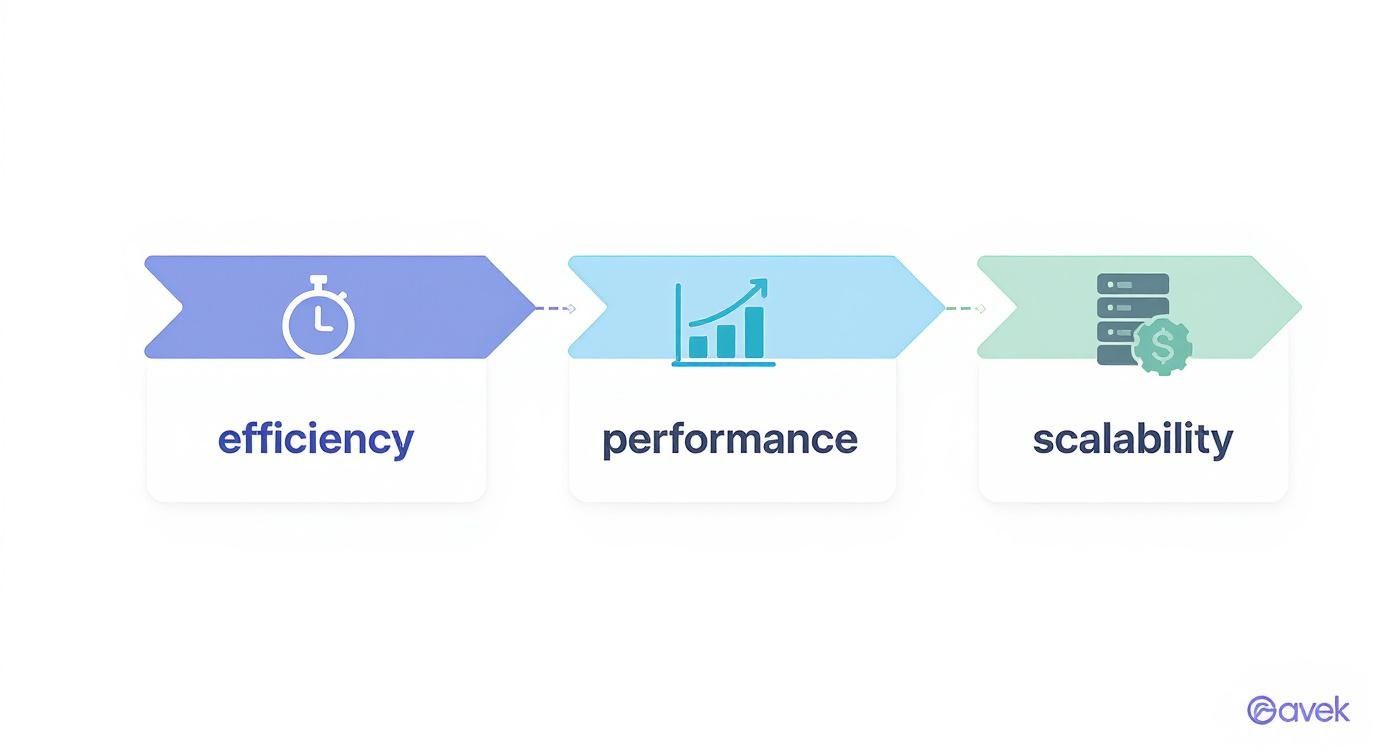
As you can see, more efficiency leads to better performance, which in turn lets you scale your efforts effectively.
Find the Perfect Ad Mix with Dynamic Creative
Trying to manually A/B test every possible combination of images, headlines, and text is a recipe for a headache. Dynamic Creative solves this by automating the entire testing process for you.
You just need to feed it the ingredients:
- Multiple Images or Videos: Give it up to ten different visuals to play with.
- Several Headlines: Write a few different hooks to grab attention.
- Different Body Texts: Craft a few versions of your main ad copy.
- Various Calls-to-Action (CTAs): Test out buttons like "Shop Now," "Learn More," or "Sign Up."
Once you provide the assets, Facebook's algorithm acts like a master chef. It mixes and matches all these components to create hundreds of ad variations on the fly. It then tests them across your audience, learns which combinations work best, and serves the winning formula to each person. This makes sure your audience sees the most effective version of your ad, giving your conversion rates a serious boost.
When to Use Third-Party Automation Platforms
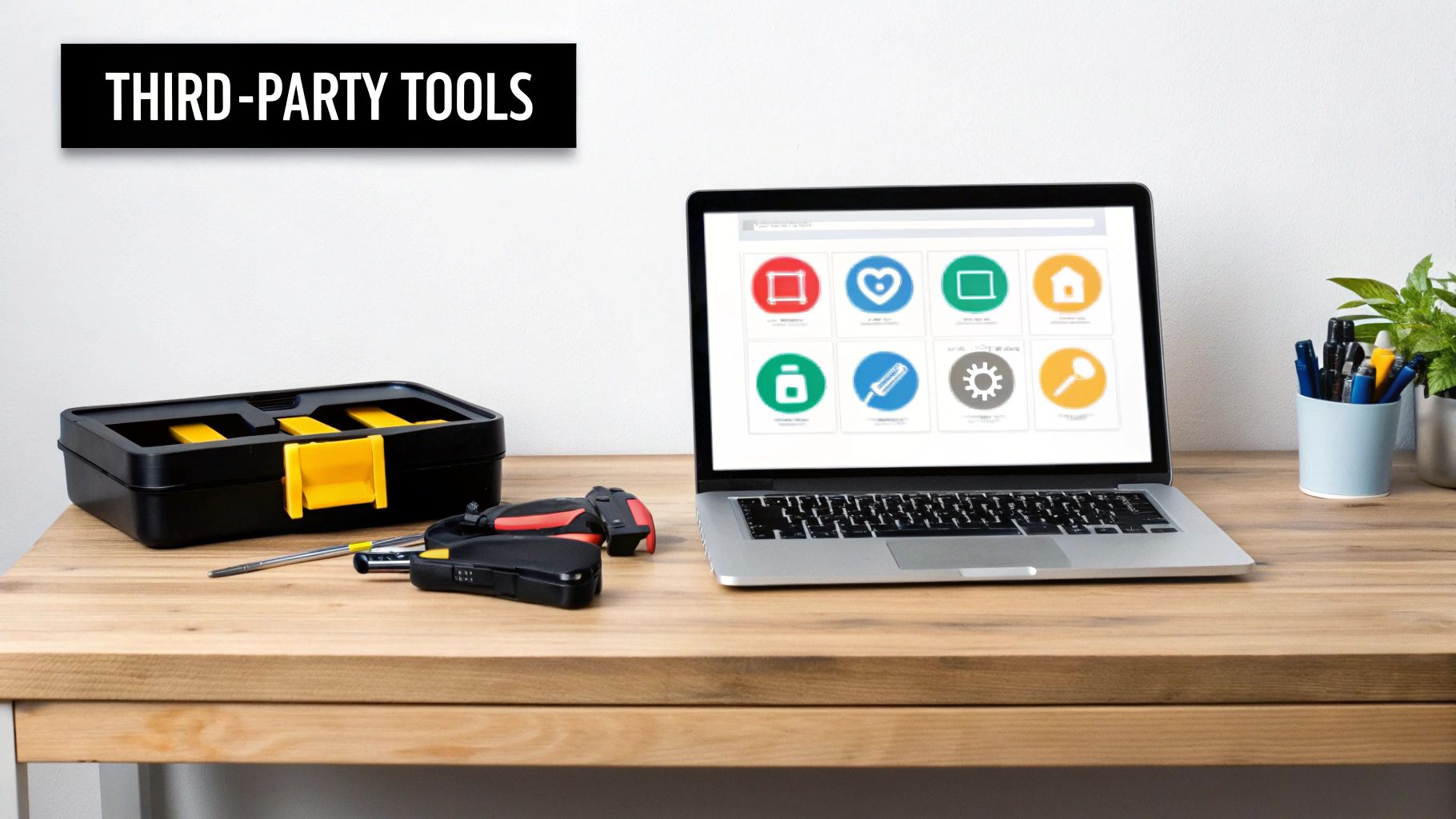
Facebook's built-in automation tools are fantastic, and for many advertisers, they're more than enough. Think of Ads Manager as a really well-stocked workshop. You can build almost anything you need.
But what happens when you need to go from building custom furniture to running a full-scale factory? That's when you bring in the heavy machinery. Third-party Facebook ads automation platforms are that industrial-grade equipment. They’re built for complexity and scale that native tools just weren't designed to handle.
Deciding to invest in one isn’t a small step. It’s a strategic choice you make when your advertising has reached a certain level of maturity.
When Your Scale Demands More Power
The clearest sign you’ve outgrown native tools is sheer volume. Once your ad spend and campaign numbers start climbing, keeping an eye on everything manually becomes a massive bottleneck. Yes, Facebook’s Automated Rules and Advantage+ campaigns help, but they have their limits.
You should start looking at a third-party platform when you're managing:
- Massive Ad Spend: Once you’re handling tens or hundreds of thousands of dollars a month, you need far more granular control over your budget and risk.
- Hundreds of Campaigns: Juggling dozens or hundreds of campaigns across different products, regions, or funnel stages is a recipe for chaos without a central command center.
- Complex Funnels: If your customer journey involves intricate, multi-channel funnels, you need a tool that can see beyond Facebook and connect the dots with your other marketing efforts.
These platforms are built to crunch enormous amounts of data and execute complex rule sets across your entire ad account in the blink of an eye.
The Major Categories of Automation Software
Instead of getting lost in a sea of brand names, it helps to think about what these tools do. Most of them fall into one of three buckets, each solving a different core problem for advertisers.
1. Advanced Rule-Based Engines
These tools take Facebook’s simple "if this, then that" logic and inject it with steroids. You can create incredibly detailed, multi-layered rules that pull in external data—like your store's inventory levels, the weather, or even competitor pricing—to make smarter, real-time decisions.
2. AI-Powered Optimization Platforms
This is where things get really futuristic. These platforms use machine learning and predictive analytics to go beyond just reacting to performance. They analyze your historical data to forecast which campaigns will perform best and automatically shift your budget to the winners before you'd even spot the trend. It's about proactive, not reactive, optimization.
3. Creative Automation and Testing Tools
For brands that live and die by their creative, these tools are a game-changer. Imagine needing to test thousands of ad variations. These platforms can automatically generate countless combinations of images, headlines, and audiences, then run micro-tests to find the winning formula at a speed no human team could ever match.
The real magic of third-party platforms is their ability to add custom logic and predictive intelligence on top of Facebook’s own algorithm. It gives you a serious competitive edge.
Native Facebook Automation vs Third-Party Tools
So, when is it time to make the leap? Upgrading brings incredible power, but it also comes with a price tag and a learning curve. The right choice really depends on where your business is today and, more importantly, where you want it to be tomorrow.
To help you decide, here’s a quick comparison of what you get with Facebook's native tools versus a dedicated third-party platform.
| Feature | Native Facebook Tools | Third-Party Platforms |
|---|---|---|
| Complexity | Low: Designed to be user-friendly for all advertisers. | High: Offers deep customization but requires expertise to manage. |
| Cost | Free: Included with your Facebook ad account. | Paid: Usually a monthly subscription based on ad spend or features. |
| Ideal User | Solo Freelancer / Small Business: Perfect for managing a moderate number of campaigns. | Large Agency / High-Growth E-commerce: Essential for big budgets and complex, data-driven strategies. |
| Cross-Channel | No: Limited to Meta's family of apps (Facebook, Instagram, etc.). | Yes: Many tools integrate with Google Ads, TikTok, and other ad platforms for a unified view. |
Ultimately, graduating to a third-party tool is a good problem to have. It’s a sign that your advertising has become so successful and complex that it now demands a more specialized system to keep the momentum going and unlock your next stage of growth.
Best Practices for Sustainable Automation Success
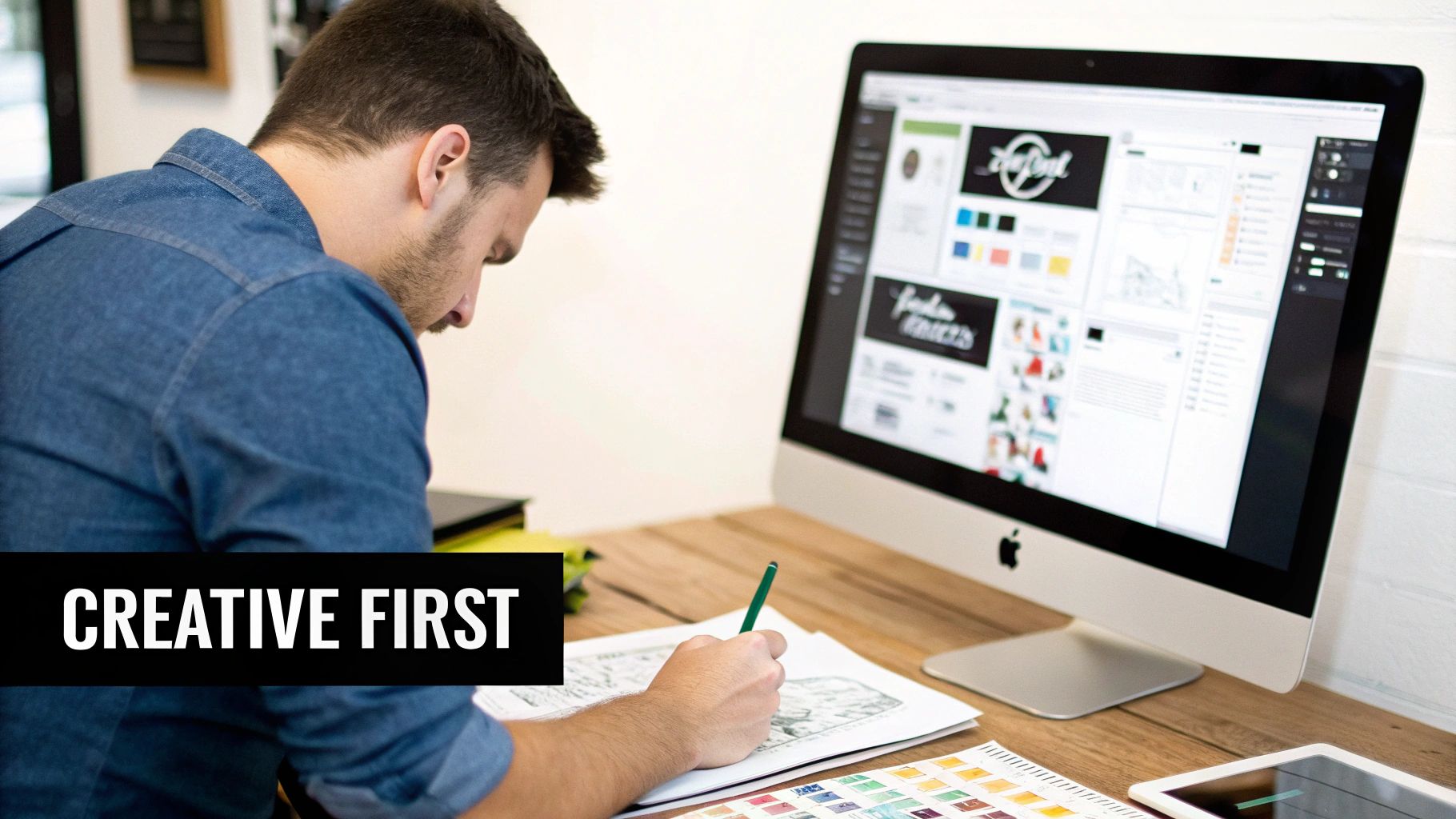
Think of Facebook ads automation like hiring a brilliant, data-obsessed assistant who works 24/7. Even the best assistant needs clear direction and good information to do their job well. Automation isn't a magic wand you wave; it's a powerful tool that works best when guided by a smart strategy.
To get those incredible, long-term results, you can't just flip a switch and walk away. Real success comes from a partnership. You provide the vision, and the automation executes it with a speed and precision you could never match on your own.
Feed the Algorithm Quality Data
Facebook's machine learning is incredibly powerful, but it’s not a mind reader. It learns and gets better based on the data you feed it. To make smart decisions, it needs enough data to spot patterns and figure out what's working.
This is especially true during the "learning phase" of a new campaign. If your budget is too low or you don't have enough conversion data to start, the algorithm might get stuck or, even worse, learn the wrong lessons.
Your automation is only as smart as the data it learns from. Giving it a healthy budget and clear conversion signals is the single most important thing you can do to set it up for success.
A good rule of thumb is to aim for at least 50 conversions per ad set each week. This gives the system enough feedback to reliably optimize your campaigns and drive better performance over time.
Never Abandon Human Oversight
One of the biggest mistakes advertisers make is treating automation as a "set it and forget it" tool. It’s designed to assist you, not replace you. Your intuition, market knowledge, and ability to see the bigger picture are things a machine just can't replicate.
Check in on your automated campaigns regularly. Make sure they’re still aligned with your real business goals. A machine can get you a low cost-per-acquisition, but it can't tell you if you're attracting low-quality leads who will never actually buy anything.
Your job shifts from being a manual operator to a strategic supervisor. Key oversight tasks include:
- Monitoring Key Metrics: Keep an eye on the big-picture numbers like Return on Ad Spend (ROAS) and Customer Lifetime Value (CLV).
- Reviewing Trends: Look for performance shifts or weird patterns. They might signal a change in the market or how your audience is behaving.
- Making Strategic Adjustments: Use your insights to tweak campaign goals, test new audiences, or roll out fresh creative concepts.
The real magic happens when you combine machine efficiency with human strategy. For a deeper dive, check out these essential marketing automation best practices that apply to any platform.
Remember That Creative Is Still King
No amount of slick Facebook ads automation can save a bad ad. Your creative—the images, videos, and copy—is what actually stops the scroll and gets someone to act.
Even with Meta rolling out AI tools that can generate 15 million ads in a single month, the core idea still has to come from a person. The algorithm can find the right people to show your ad to, but it can't invent a compelling offer or an emotional hook out of thin air.
Focus your energy on what the machine can't do:
- Understand Your Audience Deeply: What are their real pain points and desires?
- Craft a Compelling Offer: What value are you providing that they can't get anywhere else?
- Develop High-Impact Creative: Design visuals and write copy that truly connects with people.
Automation will amplify great creative, but it can't create it for you. Pair a strong creative strategy with intelligent automation, and you’ll have a truly unstoppable advertising engine.
The Future of AI in Facebook Advertising
If you think Facebook Ads automation is just about rules and simple tweaks, you're looking in the rearview mirror. The next big shift is already here, and it’s moving us way beyond basic tasks into a world driven by predictive and generative AI.
What we have today is just the starting line. The real game-changer is AI that doesn’t just optimize your campaigns but actively helps create them.
Imagine an AI that doesn't just A/B test the copy you wrote, but drafts five brand-new, compelling versions tailored to an audience you haven't even targeted yet. Picture a system that generates entirely new ad visuals on the fly, customized to what it knows will grab a user's attention. That's the power of generative AI, and it’s about to become a standard part of every serious advertiser's toolkit.
The Rise of Predictive and Generative Capabilities
The next wave of automation is all about being proactive, not just reactive. We’re shifting gears from a system that responds to data to one that predicts what's coming next. Think of it as moving from a co-pilot to a full-blown strategist.
This opens up some incredible possibilities:
- Hyper-Personalized Creatives: Forget basic A/B testing. AI will be able to dynamically generate ad copy and images that resonate with tiny, specific user segments.
- Predictive Budget Allocation: Instead of reacting to last week's performance, the system will anticipate which audiences are most likely to convert next week and shift your budget before the trend even hits.
- Deeper Ecosystem Integration: Your automation won't just live on Facebook. It'll work across Meta's entire suite—Instagram, Messenger, and WhatsApp—to create intelligent, unified customer journeys.
Navigating a Privacy-First World
As privacy rules get tighter and third-party cookies crumble, leaning on Meta's on-platform AI isn't just an option—it's a necessity. Without all that external data, your ability to find and convert customers will hinge almost entirely on the power of Meta's internal machine learning.
The platform's own algorithm is becoming the engine for targeting. If you don't understand how to work with it, you'll be left behind.
In this new era, your competitive advantage won't come from outsmarting the AI, but from partnering with it. Success means feeding it the right strategy and creative direction, then letting it do the heavy lifting on targeting and optimization.
Even in 2025, Facebook is still a giant with around 2.98 billion monthly active users. And its AI features are already putting up big numbers. Marketers who embrace tools like Lookalike Audiences are seeing up to a 30% bump in click-through rates and a 20% drop in cost per acquisition. You can find more stats on the impact of AI on Facebook ad performance.
Ultimately, getting a handle on Facebook ads automation is no longer just a nice-to-have skill. It's quickly becoming the bedrock of modern digital marketing—the one thing that will separate the advertisers who thrive from those who get left in the dust.
Got Questions? We've Got Answers
Stepping into Facebook ads automation can feel like learning a new language. Even with a solid plan, a few questions are bound to pop up. Let's clear up some of the most common ones so you can move forward confidently.
What’s the Minimum Budget to Make Automation Work?
There isn’t a single magic number, but here’s the reality: automation needs data to learn. Think of it like a student—the more practice problems they get, the faster they learn the material.
As a rule of thumb, you want a budget that can generate at least 50 conversions per ad set, per week. This gives Facebook’s algorithm enough information to get out of its initial "learning phase." If the budget is too small, the system never gets enough data to make smart decisions, and your results will be all over the place.
Will Automation Replace My Media Buyer?
Absolutely not. Think of automation as a powerful co-pilot, not the pilot. It’s brilliant at handling the repetitive, number-crunching tasks that eat up hours, but it can’t replace human strategy, creativity, or intuition.
With automation in the mix, a great media buyer’s job simply evolves. They spend less time manually tweaking bids and more time on high-impact work, like:
- Dreaming up the next killer creative strategy.
- Digging into market trends and figuring out what customers really want.
- Setting the big-picture goals that guide the entire campaign.
Automation is the "how," but the human expert is still in charge of the "what" and the "why." It frees up media buyers to be true growth strategists instead of just button-pushers.
How Often Do I Need to Check on My Automated Campaigns?
While you definitely don't need to be glued to your dashboard 24/7, "set it and forget it" is a recipe for disaster. You need to find that sweet spot between micromanaging and complete neglect.
For most campaigns, a quick daily check-in is a great habit. It only takes a few minutes to spot any weird performance dips, make sure everything is on track, and confirm the automation is doing what you told it to. For bigger campaigns with higher stakes, you might peek more often. The goal is to stay in control without getting bogged down in the weeds.
Stop wasting time manually downloading leads. LeadSavvy Pro instantly syncs your Facebook Lead Form submissions to a Google Sheet or your CRM, so you can focus on converting customers, not managing spreadsheets. Get started for free today and automate your lead flow.


